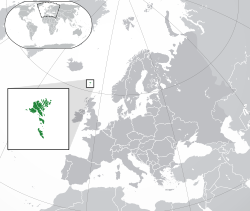Slave raid of Suðuroy
| Part of a series on |
| Forced labour and slavery |
|---|
 |

The Slave raid of Suðuroy was a slave raid by pirates from Northwest Africa that took place on Suðuroy in the Faroe Islands in the summer of 1629. It resulted in the abduction of over thirty people, mainly women and children, who were evidently not ransomed and lived their lives in slavery on the Barbary Coast of North Africa.
Background
[edit]The isolated Faroe Islands had a long history of problems with pirates as well as fishermen intruding on the islands' fishing waters. Because of its geographical position, and its small population with limited possibilities to defend themselves, the islands became a popular resting place for pirates, who stopped along its beaches to pause. During those pauses, the poor and defenseless population were sometimes exposed to pillage and theft, and were unable to defend themselves other than by running to high mountainous terrain and by throwing stones at the pirates. Raids by Irish, English and Barbary pirates became worse in the early 17th-century.[1]
In 1607, both Iceland and the Faroe Islands were subjected to a slave raid by the Barbary pirates, who abducted hundreds of people for the slave markets of North Africa.[2]
The raid
[edit]
In the summer of 1629, three Barbary pirate ships with 500 pirates entered the bay of Hvalba in Suðuroy. They had a Faroese guide, the brother of the owner of the Nøstgaard farm, who felt that his brother had cheated him on his inheritance, and who showed the pirates to his brother's farm and the rest of the parish.[1]
Parishioners fled to hide in caves and between rocks in the highlands. Six people were reportedly killed during the pillage, while over thirty women and children were abducted. Among the children taken were the seven-year-old son of the parish vicar Hr. Povel. The vicar reportedly, in his desperation, sang a galdr song against the pirate ship containing his son. This was seen as the reason that this ship went aground, which caused all on the ship, including the vicar's son, to drown, causing his father to become mentally unstable for the rest of his life.[1]
The remaining ships left the island the day after the attack. Those inhabitants in hiding testified afterward, that they could hear the cries from the captives from inside the pirate ships when they left.[1]
Legacy
[edit]
On 6 July 1629, the survivors and authorities wrote a letter to King Christian IV to ask for his protection against the pirates. When informed about the women and children abducted, the king ordered the Faroese population to collect a ransom for the prisoners to save them from slavery. However, the Faroese replied that the poverty caused by several years of piracy on the island, had made it impossible to collect the money necessary to buy the prisoners back.[1]
Skansin fortress in Thorshavn was built in 1630 by order of the King to enable the population to defend themselves. Pirate raids continued throughout the seventeenth century, however no successful raids are noted until the 1660s.[1]
See also
[edit]References
[edit]- ^ a b c d e f Niels Andreas Christian Andersen (1895). Faerøerne, 1600-1709 (in Danish). New York Public Library. G. E. C. Gad. pp. 234–254.
- ^ H. C. Bering. Liisberg Danmarks søfart og søhandel. Bind 1, Volym 1


 French
French Deutsch
Deutsch